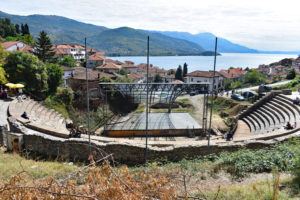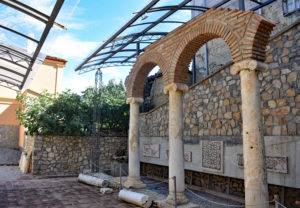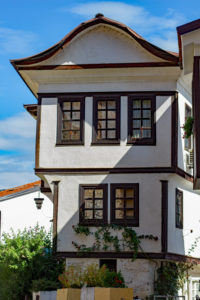We stayed for three nights at the “City Palace Hotel”:https://www.silvertraveladvisor.com/review/accommodation/203485 on the edge of Lake Ohrid, said to be the jewel in North Macedonia’s crown. Both the lake and town are under UNESCO protection: the former is one of the oldest in the world, and the latter has roots dating back to Neolithic times. It’s one of only 28 UNESCO sites that are Cultural as well as Natural. Although we had a half-day guided tour, we made the most of our free time.
In the 17th century, there were 365 churches within the city boundaries and, whilst that number is now much smaller, there are still many, and it’s often referred to as the ‘Jerusalem of the Balkans’.
In the construction of the 11th century Church of Saint Sofia, lime was used in the mortar, which allowed the building to withstand tremors over the years. Unlike others we’d seen, the interior was relatively plain as many of the original frescoes were coated with whitewash when it was converted into a mosque in 1466. Then, during the second Balkan war of 1913, the mosque was used as a warehouse, before being reconverted back to a church. During the second half of the 20th century, the whitewash was removed from some frescoes, and it is one of only two churches in the world displaying such a high number of well-preserved 11th century frescoes. Around the back, a colonnade was added in the 14th century by Gregarious who carved his name above: this is depicted on the reverse of the 1,000 Denar note. It was built with the natural travertine stone, formed in hot springs, which resembles a sponge with holes.
Walking further out to the edge of the town we came to Polyconchal Basilica at Plaoshnik which is currently being excavated, with much of it under cover to protect the mosaics. An earthquake in 518 AD had destroyed 20 cities across an area 250km in diameter and this is one that was hidden away.
Nearby, behind the excavation works, stood the Church of Saint Clement with its magnificent mosaic above the doorway. It had been levelled by the Ottomans and not found until 1960 and took 40 years to reconstruct. A statue of Saint Clement resides in the main town square and features a large forehead and book in his hand to signify learning and education.
Because of the number of churches, many share the same name and to distinguish them, they’ve been given an additional name, connected with their location or history. In the central town area, stood the tiny Churches of Saint Bogorodica and Saint Nikola, found either side of a small lane leading from the town wall to the Lake. Built in the 14th century as hospital churches, Bolnička was added to the name as ‘bolnica’ is hospital in Macedonian. Bogorodica was for women and is now more of a social place where people say a quick prayer and stop for a coffee and a chat. Inside the lady who looks after the building, with its walls adorned with religious photos and art, kept saying ‘small but beautiful’. Nikola, for the men, is some 70 years older than Bogorodica and is an interesting construction of an older church inside a newer one, although it now appeared to have a pizza restaurant in its back yard (I later discovered the dining terrace of Pizzeria Leonardo backs onto the grounds).
The Church of Saint Jovan Kaneo is said to be the most visited church because of its location on the cliffs directly above the lake. To reach it, we took a scenic route from our hotel, firstly along the lake shore and then a boardwalk that hugged the cliffs. Passing tiny stone beaches with tightly packed white loungers and a couple of jetties, eventually, after a steep climb up a narrow, cobbled path, we reached the 13th century church and entered to see the frescoes. We also took the obligatory photos of this very scenic location that grace many a travel book.
Tsar Samoil’s Fortress is set high on a hill in the old town and after a morning out in the car, we were delighted when our driver suggested taking us up as far as he could by car (only residents living in the neighbouring area can drive to the top). However, it was still a steep climb to the entrance where we were told that the 3km city walls are the second longest in Europe, after Dubrovnik. Until the Ottomans arrived in Ohrid in 1395 the town was completely enclosed within the walls, with two entrances, the Upper Gate and Lower Gate. However, afterwards, the town expanded beyond the original walls, with the Christian population within the walls, and the Ottomans outside. In 2002, a golden royal funeral mask and glove were discovered by Pasko Kuzman, who is said to be frequently seen walking his dog along the shores of the lake. The mask is on the 500 Denar note.
On our walk down from the castle, we passed a half-finished Museum with its three floors dedicated to manuscripts, icons and theology. Although there are already other buildings dedicated to these subjects, the theology students protested saying they needed peace and quiet. It was obviously controversial, as UNESCO had intervened, querying the need for such a large building. Although they agreed that the building should be completed, they restricted further planned buildings and the felling of more trees.
We passed the 2nd century Roman amphitheatre which lay undiscovered until the early 20th century, as it had been covered by the 518 earthquake. 2,400 seats have been uncovered to date, although more are hidden. It is used for events including the Ohrid Summer festival, which has been going for 60 years, as the acoustics are excellent: Vanesa Mai opened the festival in 2018.
There’s a joke in Ohrid that people are afraid to plant a flower, for fear of what they will find when they dig down. We saw a building which the owner had wanted to extend, but during the digging of the foundations found ruins, which led to a year’s delay. Another property with plumbing problems had discovered during digging, 4th century ruins, still awaiting excavation: it wasn’t clear whether they had resolved the plumbing issue. At the home of the Manchevi family, an information board showed what had been buried by the earthquake. There were columns with marble from Prilep, 150km away, indicating family wealth, and mosaics. The names of the investors, Johan and Tomas were created in the mosaics, which was said to be unusual. Two techniques were described: ‘opus tessellatum’ where the tiles are small and uniform, and ‘opus vermiculatum’ where the design is created, and the tiles cut to fit.
Walking down through the pedestrianised streets of the old town, we spotted unusually shaped streetlamps, based on the design of the home of the fishing family, Crajavi. The design of these houses, unique to Lake Ohrid, are smaller at the top with larger protruding floors added as the family expands.
The National Museum of Ohrid is situated in two former family homes built in the traditional style: the Urania residence with its ethnographic items, and the Robev house with archaeological displays. The latter is also one of the finest examples of 19th century Macedonian architecture with steep stairs and a room at the top where the ladies would meet to chat when the men were away. Nearby was the National Workshop for Handmade Paper, a museum-cum-shop with one of only two copies of the Gutenberg Press in the world. Although there were demonstrations of the paper-making process and handmade paper products for sale, it was always crowded when we tried to get in.
In jewellery shops we spotted two unique items. The first was Ohrid pearls made from the scales of fish. There are only two families who can trade them: Filev, whose client includes the Queen of Sweden and Talev, who have made pearls for our Queen. The second was rubies, as North Macedonia is the only country in mainland Europe to have naturally occurring rubies, found mainly around the city of Prelip, which have a unique raspberry colour.
The final pedestrianised street on the eastern edge was lined with modern shops. It led to a square with a large unworking fountain and a 900-year-old plane tree known locally as Činar. Allegedly at some point in its history, it housed a barbers shop and later a tiny café. Two mosques in the area reflected its Ottoman past and on a main street we found many eateries selling mainly Turkish kebabs. Here men on bicycles balanced trays, hung from a chain, containing glasses of tea, which were being delivered to the shop keepers.
There is plenty of sights to keep you occupied in Ohrid for a few days and as well as sightseeing, we enjoyed strolling along the promenade and watching people feed the elegant swans despite the valiant efforts of the gulls to intercept the bread.
Wizz Air has direct flights to Ohrid (around 3 hours) and I’d certainly recommend it as an alternative to the touristy Dubrovnik as being on the Lake, it doesn’t get overrun with cruise ships.










